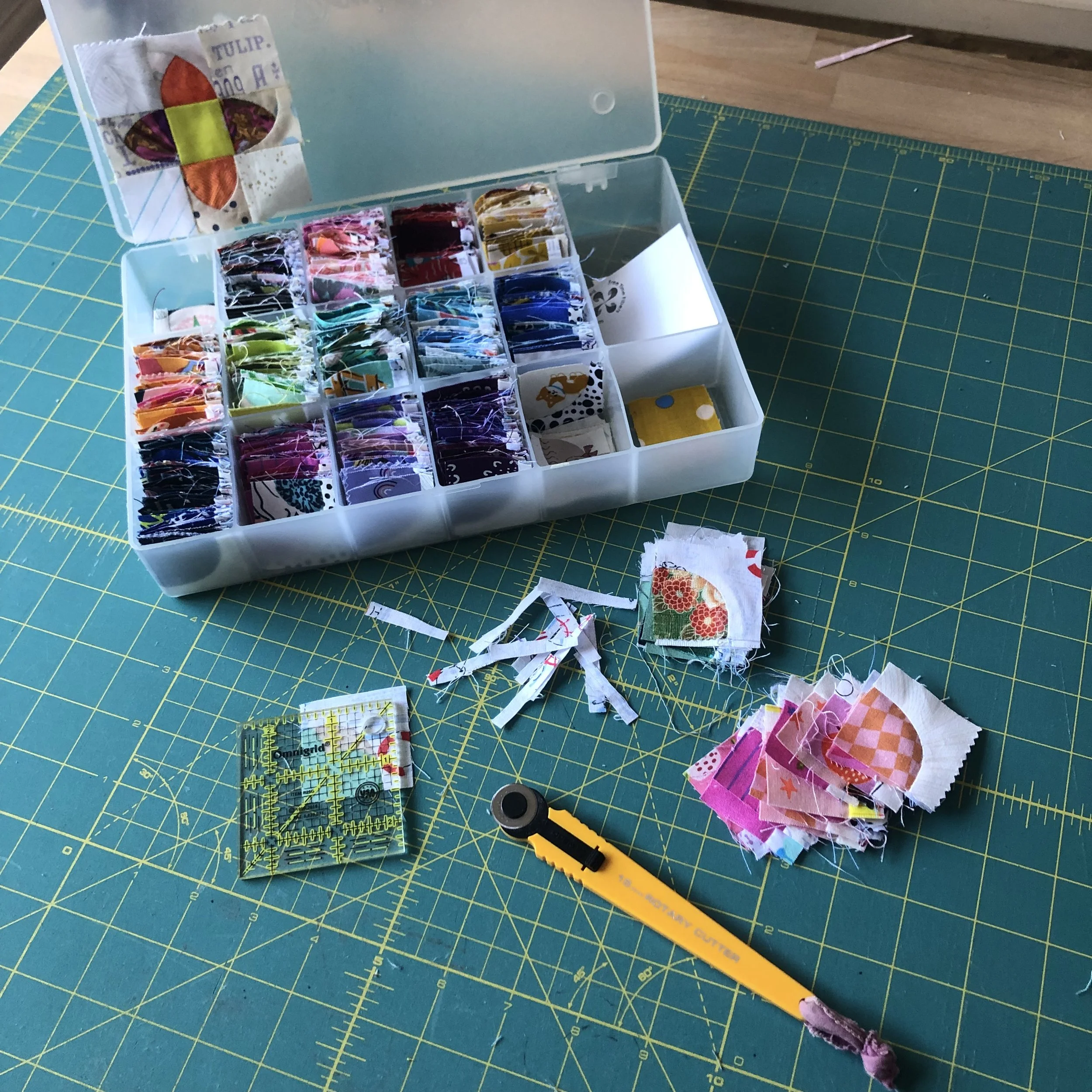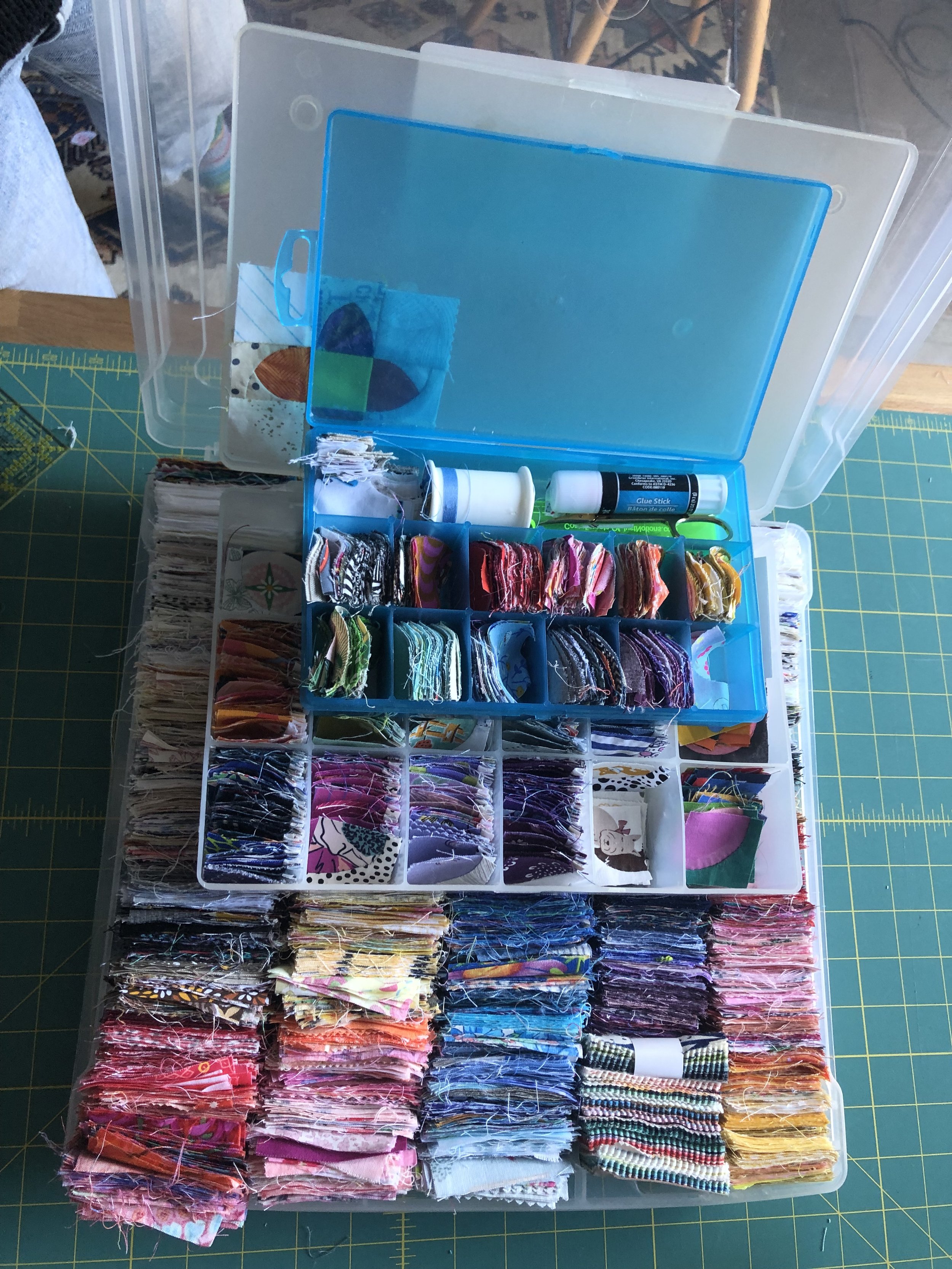Scrap Sorting Day 2023
The Modern Quilt Guild has designated November 4th as International Scrap Sorting Day. I do love myself some scraps, but sometimes it seems I just love collecting scraps. I can’t bare to waste those colorful little bits and am excited to work them into future projects. So scrap management and organization is a regular part of my sewing routine.
When to sort? Anytime that works! Nov 4th is a good excuse to start. Maybe it’s a monthly occurrence for you. I like to organize after I complete a project - clean the slate for the next project. I usually have a goal not to start another project until my scraps are organized and the space is clean. Other times, I spend an hour every month cleaning and organizing. I keep a basket at my cutting space as a “holding area” for larger scraps waiting to be sorted/organized.
I’m ready to sort! Let’s do this! Wait, wait, hold on… Take a minute to breathe and think first. This might be exciting or dreadfully daunting depending on your mindset, make sure you’re really feeling ready. Things might get really messy before they get really clean, and that’s OK. Think about what is true and realistic for you - you are an expert on yourself, sewing routines, and space. Meditate on some personal questions like those below that might guide your process:
How do you like to sew? Is it methodical and precise? Are you more improvisational? Do you like using scraps for paper piecing or traditional piecing?
What is the smallest size of fabric you’d realistically use? Fat eighth? 10” squares? 5” squares? Crumbs? No use in organizing what you won’t use.
How much time, money, and mental bandwidth do you have to devote to this? Are you excited by organized jars or boxes of fabric color? Or is tossing fabric in a plastic bag of fun a more realistic organization technique for you? Can you upcycle or thrift storage containers, jars, or shelves? Any community groups like a Local Buy Nothing group in your community you can ask for organizers?
What are your space limitations? Can you utilize underutilized space with shelves, under-table organization, drawers, hooks and hanging organizers, etc? Do you need storage that can easily be moved and stowed away?
How to organize? This all depends on what works for you. I use a combination of techniques.
If leftovers are quite large (7” or more), I fold them into a fat quarter or fat eighths and store them separately.
Pre-cut to common sizes. For me, this means 5”, 2.5”, and 2” squares. I store my 2.5” and 2” squares in rainbow order in a 12”x12” plastic container for scrapbook or paper organizing. If you like EPP, cut fabrics to common sizes you would use for those shapes.
Strips. I keep fabric strips 2.5” wide or less in their own box to use for scrappy binding or a strip-pieced project.
I also pre-cut crumbs into curvelets for travel sewing. These are stored in a plastic compartment container (for beads and hardware and such). I always thrift these compartment containers when I see them.
Crumbs. These get thrown into plastic bags because I use them improvisationally. I have one for patterned crumbs, one for solids, and one for half-square triangles. I make quilted postcards or crumb blocks, but they would also be good for FPP. Crumbs can also be organized by color in thrifted jars on a shelf or in sandwich baggies you store in a box.






What about the fabric that no longer serves me? Fabric that was gifted to us, we bought it at a different time in life, it’s just not our style, it’s too small to use in the projects we like. DONATE! To a guild free table, to a new sewist, to a charity quilt organization, to a local thrift store. Ask your sewing friends if it’s their style or if they are a crumb quilter (you can never have enough crumbs). SELL it on Feel Good Fibers, at a yard sale, or a guild sale.
What about the “fabrifetti”? That trash bag full of thread snips and trimmings… Many people suggest using it for stuffing, like in a pillow, pouf, pet beds. You can make textile art with these bits, or save long strips for gift wrapping “ribbon”. Pure cotton fabrics and scraps can be composted - sometimes I put my cotton thread trimmings in the compost bin the city collects. I use a fabric recycling service like Retold Recycling or For Days. The recycle bags cost around $20 and I typically fill about one bag a year.
Whatever you do, remember that you can do whatever you set your mind to. Celebrate the small wins! You will likely not finish everything in one day, or maybe even a week. And as you sew, you will will always have more to sort, so find a process that works for you. Put on some music, a podcast, or your favorite bingeable TV show and have some fun!
